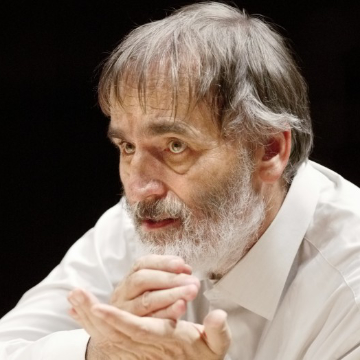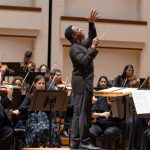October 9, 2025
Miller Theatre, Columbia University School of the Arts
New York, New York – USA
JACK Quartet Quartet (Christopher Otto & Austin Wulliman, violins; John Pickford Richards, viola; Jay Campbell, cello).
Helmut LACHENMANN: String Quartet No. 3 “Grido” (2001)
Helmut LACHENMANN: String Quartet No. 1 “Gran Torso” (1971/78/88)
Helmut LACHENMANN: String Quartet No. 2 “Reigen seliger Geister” (1989)
Ben Gambuzza | 13 OCT 2025
Some musician (no one seems to know whether it was Mozart or Debussy or Miles Davis or what) once said something like, “The music is not in the notes, but in the silence between the notes.” The elusiveness of the quotation’s originator is perhaps a testament to the universal validity of its message. Anybody throughout human history could have said this, and it would be true.

Helmut Lachenmann (Klaus Rudolph, CC BY-SA 4.0, cropped)
German composer Helmut Lachenmann’s string quartets take this notion of the primacy of silence to its extreme. In fact, as the JACK Quartet played all three quartets Thursday evening at Columbia University’s Miller Theatre in celebration of the composer’s 90th birthday next month, I kept thinking, These things hardly exist. At times, the silence and mundane sounds of the concert hall and its audience were louder, more substantive, more existent, than the music of the actual score—music which often threatens to achieve silence like a mathematical limit on a graph: approaching, but never reaching, zero.
But this is a different sort of appreciation of silence from, say, John Cage’s 4’33”. Cage extinguishes the musical score into non-being—in this way, the score itself reaches a sort of nirvana—forcing the audience to listen to the sounds around them: coughing, stomachs rumbling, a car revving outside. In contrast, Lachenmann acknowledges the silence and mundane sounds of the audience and its surroundings, and adorns it with music. One ornaments the other; one does not exist at the expense of the other.
The effect, then, of listening to these quartets is as if you’re looking up into a blue sky dotted with clouds, listening to the whirling wind, the jets above, the birds twittering, while around you, you can still hear people speaking, your feet crumpling leaves on the ground, a distant siren. You’re aware both of your surroundings and of a realm of the universe you’ll never visit. It’s like being in a cave in heaven. You hear both the immediate crackling of your habitat and the howls of some far-off angel, out there. Needless to say, listening to these quartets on a recording gets you nowhere close to experiencing this physically stunning effect.
Every JACK Quartet performance is a miracle. But every miracle is different. Thursday evening was more like walking on water than turning water into wine. The ensemble played the quartets out of order; the String Quartet No. 3 “Grido” (2001) came first. The players’ cool hands and precise execution treated the music like a butterfly wing on one hand and, on the other, a two-by-four that needed sawing.
This mix of delicacy and violence is found in other composers (it might even be a German thing; Beethoven was the first to experiment with sublimity like this), but it’s pure Lachenmann to write a mixture such that each quality sounds as if it is about to break out into the other: serenity into terror, wrath into placidity. A constant tension. Excruciating anticipation.
JACK understands the urgency and wonder of Lachenmann. They also understand that, while music is always a language (akin to the language of myth, which, as the anthropologist Claude Levi-Strauss thought, also articulates the inarticulable), the language here is often like a parliament of owls debating a bill rather than a leisurely chat between friends. At times, I was reminded of a moment from the “March to the Scaffold” movement of Berlioz’ Symphonie fantastique, where the melody is traded throughout the orchestra, and at one point a single note is taken up by, of all instruments, the cymbals.
Just as Berlioz deconstructs the idea of a melodic whole by dispersing the theme throughout the ensemble, Lachenmann’s music is consistently fragmented, making it sometimes difficult to see the whole from the parts. But the whole emerges once you let yourself appreciate how disparate sounds talk to each other: a fast-forwarded glissando, a timpani-like boing, a haunted house creaking door, a clown bending and twisting a giant balloon, a fleeting ghost of a major scale. Happy Halloween.
Maybe I need the wax flushed out of my ears, but there were times in the third quartet when I found myself leaning forward, lending my ear, not wanting to miss any of the ensemble’s pianississississimos.
The String Quartet No. 1 “Grand Torso” (1971/77/88) made me strain my ears even more. Even the sound of violinist Christopher Otto pulling a stray hair (broken during the sawing?) from his bow was not to be missed. For minutes and minutes, the players bowed the wood at the edges and the bottoms of their instruments in barely discernible rhythms. Around me, stomach gurgles, rustles of fabric as audience members crossed their arms and legs—this was silence with a veneer of sound. I had to open my eyes to make sure JACK was still alive.
Finally, in the String Quartet No. 2 “Reigen seliger Gesiter” (“Round of the Blessed Spirits”) (1989), the audience was treated to semblances of harmony, and diatonic harmony at that. The appearances were infrequent, but this quartet is more about pitch than the other two. Lachenmann is always concerned with timbre, and every quartet uses extended techniques that, according to Donna Lee Davidson’s program note, were alien to the ensemble before taking up Lachenmann’s music over twenty years ago.
But here, the aggressive plucking and strumming of the players—phantasmagoric guitars—made the music sound a little more terrestrial than the two other atmospheric, otherworldly quartets. The faint click of Otto’s guitar pick as it dropped onto the floor was the final reminder that we musicians and listeners are merely earthlings, and our faults are simply part of the music. ■
EXTERNAL LINKS:
- JACK Quartet: chambermusichouston.org
- Helmut Lachenmann: breitkopf.com/composer/561/helmut-lachenmann
- Miller Theatre: millertheatre.com/

Read more by Ben Gambuzza.
RECENT POSTS
 Luisi and Dallas Symphony revel in Respighi, Bruce Liu excels in Saint-Saëns’ ‘Egyptian’ Concerto • 13 Oct 2025
Luisi and Dallas Symphony revel in Respighi, Bruce Liu excels in Saint-Saëns’ ‘Egyptian’ Concerto • 13 Oct 2025 Kwamé Ryan and the Charlotte Symphony, with violinist Gil Shaham, deliver a rapturous all-Tchaikovsky evening • 11 Oct 2025
Kwamé Ryan and the Charlotte Symphony, with violinist Gil Shaham, deliver a rapturous all-Tchaikovsky evening • 11 Oct 2025




.png)